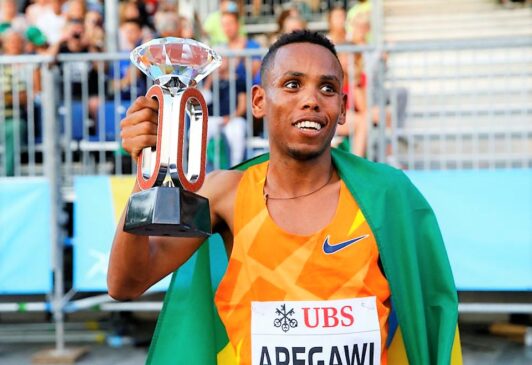Emergent Middle-Class Brings New Retail Culture in Addis
By Asmeret Haileselassie
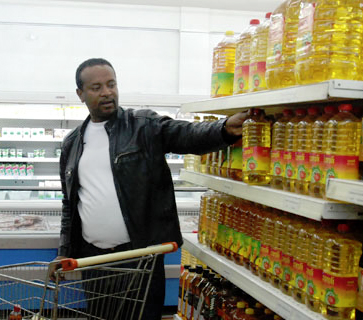
Addis Ababa, Ethiopia - On the late afternoon of one Monday, Efrem Ketema, in his 40s, was pushing a trolley along the aisle inside Bambis Supermarket, on Jomo Kenyatta Street, stuffing it full of items like – flour, oil, pasta, egg, tuna, meat, and vegetables. He was making one of his two regular weekly visits to the supermarket.
For a man who works as an insurance agent for Nile Insurance and earns a monthly income of 20,000 Br, spending 871 Br that shopping day was not off the mark.
In the same week, Tigist Kassa was picking items, such as – packed juice, tea leaf and bottled water at Novis Supermarket, on African Avenue (Bole road). A secretary at a government agency, Tigist earns 5,000 Br in monthly income. This may seem a little more the average Ethiopian pay, but her husband, adds 50,000 Br to the household’s monthly earnings. Visiting supermarkets four times a month is thus within their budget, spending 10,000 Br each month.
The households where Efrem and Tigist come from represent the emerging middle and upper classes in Addis Abeba, whose consumption pattern is unprecedented in the Ethiopian economic history. They are what the Paris-based consulting firm, Sagaci Research, claims are part of the 24pc of households in Addis Abeba that earn monthly income of 500 dollars or more.
Founded in 2012 by former consultants from the Boston Consulting Group, Sagaci Research claims to have carried out surveys on close to 1,000 households in Addis Abeba, from May to June, 2013. Its findings, if corroborated by other surveys, would change the way wealth, and the size of those who hold it, is perceived in the nation’s capital. Those who earn more than 500 dollars, such as Efrem and Tigist, are estimated to reach 200,000 households, representing one third of Addis Abeba’s households.
This is a sharp disparity from the rest of the country, where only one per cent of the population makes an income over 500 dollars. But, in Addis Abeba, even among the 200,000 households Sagaci identified, a segment of 10pc earns more than 1,000 dollars a month.
A good part of this income is spent on consumption, which makes people like Efrem and Tigist attractive for the budding modern grocery retail business in the capital. It is such demand that is expected to add 15 to 20 new supermarket outlets to the eight that have been in business for over a decade.
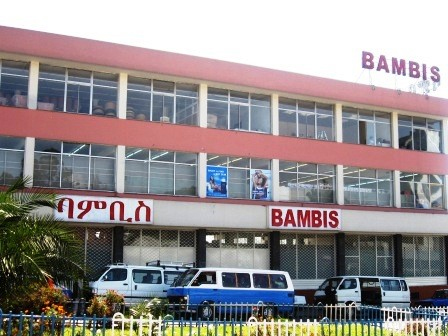 The largest among these is Bambis, whose 1,500sqm, one-storey outlet was returned to the Greek family in the mid 1990s, after two decades of state ownership. Bambis and his family had lost their properties to the revolutionary zeal of the mid-1970s, before they fled to save their lives following the deposition of Emperor Hailesellasie by junior army officers, in 1974. He came back to reclaim his property, built in a prime location of the city, and continue his supermarket retail business from where he had left off.
The largest among these is Bambis, whose 1,500sqm, one-storey outlet was returned to the Greek family in the mid 1990s, after two decades of state ownership. Bambis and his family had lost their properties to the revolutionary zeal of the mid-1970s, before they fled to save their lives following the deposition of Emperor Hailesellasie by junior army officers, in 1974. He came back to reclaim his property, built in a prime location of the city, and continue his supermarket retail business from where he had left off.
Commanding a clientele made up largely of expats, Bambis has been the largest player in the modern supermarket business in Addis Abeba, with its size claiming one fourth of the combined 15,300sqm of all eight supermarkets.
This is no longer the case, however.
One of its competitors, Shoa Shopping Centre, has opened a brand new 3,000sqm supermarket its managers have dubbed “hypermarketâ€Â. Located in the basement of the Zefemesh Building, on Equatorial Guinea St (in Megenagna area), Shoa’s Hypermarket probably signals the beginning of the arrival of 10 such supermarkets, Sagaci Research projects will commence business between now and 2018. They will run a combined space of between 175,000sqm and 275,000sqm, according to the French consulting firm.
In five years, the consulting firm, which has commissioned the survey on its own, anticipates expenditure in supermarkets to grow to 1.5pc of total grocery spending, from 0.5pc now.
The aim of the survey was to provide the latest data about Ethiopian consumers and their growing appetite to multinational corporations and potential investors, Julien Garcier, partner and managing director of the firm, told Fortune.
This is despite the nation having an investment law that puts retail business off the mark of foreign direct investment. Nonetheless, the growing number of people, such as Efrem and Tigist, with an aggregate purchasing power of 100 million dollars (close to two billion Birr) a month and their changing consumption pattern is a lure to foreign investors. WalMart, the world’s largest retailer, for instance, had been in hot pursuit of a deal with the Ethiopian government, in order to enter the market with a cash and carry arrangement, but to no avail.
Eventually though, many believe that the government will surrender the retail market to foreign investment, particularly whenEthiopiajoins the multilateral trading platform, the World Trade Organization (WTO).
However, Ali Siraj, state minister for Trade, says joining the WTO does not necessarily lead to the amendment of investment laws in favour of FDI. He refers toIndia, which opened its retail market to foreign investors many years after its membership with the WTO. For now, the federal government has hired a Chicago-based consulting firm, AT Kearney, to manage its newly incorporated trading enterprise, for two years.
Eyeing the annual aggregate income of 24 billion Br that Sagaci identifies among the middle class in Addis Abeba – five percent of the nation’s 800 billion Br GDP – the new enterprise hopes to modernise and enhance the nation’s retail market.
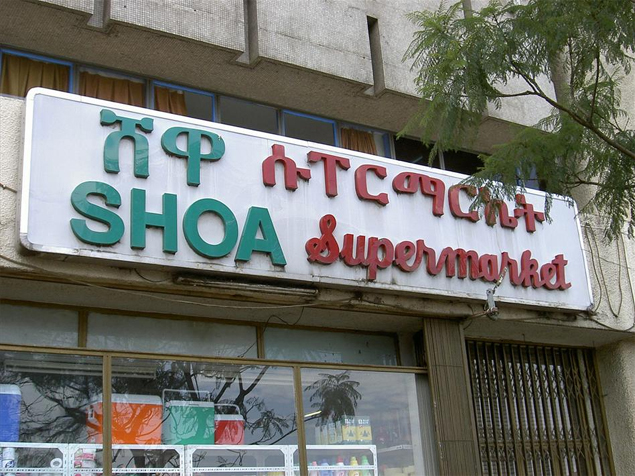
The growing middle class and its changing consumption pattern is not a surprise for Tsegabirhan Woldegeiorgis, an economics lecturer at the Addis Abeba University. The country’s development direction has already indicated the expansion of middle income households, as well as market efficiency, healthy growth and women’s equality, he told Fortune. It is a class characterised by a smaller family size and ownership of household goods, such as a refrigerator, telephones and automobiles.
This is indeed what defines the living standard of people such as Tigist and Efrem. They both drive cars, own smart phones and villas, while they send their children to private schools. Efrem pays 3,250 Br a term for each of his two children, whilst Tigist pays 40,000 Br for her two children each, annually. Tigist’s villa, which was bought for two million Birr, is found in the Ayat neighbourhood. Addis Abeba has seen the construction of such villas, largely one-storey and three bed-rooms, reaching close to 15,000 units over the past decade and a half.
Frequenting supermarkets is also an indication of those in the middle income group, as regular spending at supermarkets costs a little more than irregular visitors could have afforded, according to Tadele Ferede (PhD), an economics lecturer at Addis Abeba University.
What is happening in Addis Abeba, where the middle class makes up 8.2pc of the whole population, is actually the reality ofAfrica. A 2010 study by the Africa Development Bank (AfDB) shows thatAfrica’s middle class has increased to 34pc, or 350 million of its total population, an increase of 27pc from the 1980s.
The middle class inAfricais the source of private sector growth, the main consumer of goods and services supplied by it, according to AfDB. The total consumption of this income group inAfricais increasing, estimated to have reached around 680 billion dollars in 2008.
Ironically, however, the size of the population that shops at high end supermarkets, such as Bambis and NOVIS is still very marginal – a fact concurred by the supermarkets themselves.
Panos Asimacopoulos, import manager at Bambis Supermarket, sees many of their customers as foreigners, followed by Ethiopians coming back from the Diaspora. If the local customers come to shop, their spending is often limited to basic food items. For instance, the number of foreign shoppers was far larger than locals at Bambis late afternoon of September 17. The same was the case at NOVIS.
As customers in these supermarkets are predominantly foreigners, 90pc of their items are also imported. This is of concern to Tadele, who believes that an overreliance on imported food items eats into the scarce foreign currency reserve of the country, which should be spent on capital goods and machinery. The growth of the supermarkets has to run alongside growth in agro-processing industries, which could supply the supermarkets, if the growth is to be sustainable, according to Tadele.
Despite locals being under-represented at Bambis and NOVIS, the number is high at the Shoa Hypermarket. Girmay Alemayohu, manager of the newly opened Shoa Hypermarket, says consumers from low income groups are flocking to the store as goods that match with their income are sold at the same price as traditional markets.
In the same way, Shifa Mohammed, general manager of the Shoa Supermarket at Bole, says that although the expansion of the middle income class could be a reason for increased consumption at supermarkets, the awareness of people from low income groups could also be a reason, as their number is increasing through time.
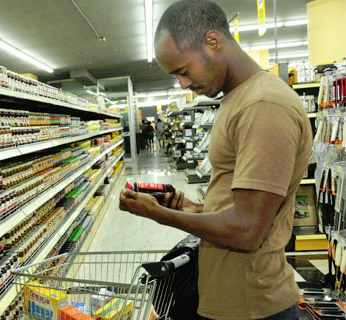
In fact, among the six people shopping on Thursday, 05, 2013, at Shoa Hypermarket, only one had a monthly salary exceeding 7,000 Br. Natenael Melaku, one among them is a supervisor at a hotel. The aggregate monthly income of Natenael and his wife is 5,000Br.He could shop with a price equal to the traditional market, such as half litre of bottled water and a kilo of meat he had picked that day. It cost him four Br and 120 birr, respectively – a price similar to the outside market, even lesser in the case of the bottled water, which costs five birr on average in traditional markets.
The supermarket has devised a marketing strategy to attract people like Natenael. One among them is what the supermarket calls “weekend surpriseâ€Â. Three weeks ago, the supermarket sold a kilo of sugar for 9.50 Br, while its price was 14.50 Br outside.
With both local dwellers and foreigners buying goods from the increasing number of supermarkets, multinational corporations and local investors are eying Addis Abeba and its growing shoppers for a fat return to their investment.
“Ethiopiais an attractive market for us (and our clients) as it is developing fast,†Garcier told Fortune.
Source: AddisFortune.com



